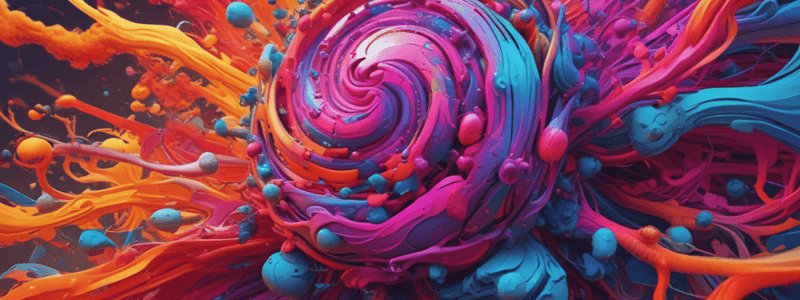Podcast
Questions and Answers
Which property describes the relationship between stress and strain for biological tissues when the stretch is relatively small?
Which property describes the relationship between stress and strain for biological tissues when the stretch is relatively small?
- Elastic region
- Hooke's law (correct)
- Plastic region
- Yield Point
In bending of an object, which side becomes convex?
In bending of an object, which side becomes convex?
- The unstressed 'neutral axis'
- The whole bent area
- The side in compression
- The side in tension (correct)
Which type of bending occurs when a compressive force acts off-center from the long axis of an object?
Which type of bending occurs when a compressive force acts off-center from the long axis of an object?
- Long bone bending
- Four point bending
- Cantilever bending (correct)
- Three point bending
Where are the highest tensile and compressive stresses located in a bent object?
Where are the highest tensile and compressive stresses located in a bent object?
What type of forces produce bending in an object?
What type of forces produce bending in an object?
In four point bending, where does failure typically occur?
In four point bending, where does failure typically occur?
What is the relationship between the radius of a shaft and its resistance to torsion?
What is the relationship between the radius of a shaft and its resistance to torsion?
Which of the following is NOT a characteristic of biological materials?
Which of the following is NOT a characteristic of biological materials?
How does the fluid component in biological tissue affect the material's stress-strain behavior?
How does the fluid component in biological tissue affect the material's stress-strain behavior?
What is the relationship between an increase in strain rate and the stiffness of a viscoelastic material?
What is the relationship between an increase in strain rate and the stiffness of a viscoelastic material?
What is the term used to describe the energy lost in a viscoelastic material due to internal friction?
What is the term used to describe the energy lost in a viscoelastic material due to internal friction?
Which of the following properties is a measure of the capacity of a material to sustain permanent deformation?
Which of the following properties is a measure of the capacity of a material to sustain permanent deformation?
Which of the following best describes the initial cycles effect of material fatigue?
Which of the following best describes the initial cycles effect of material fatigue?
What is the key difference between elastic and plastic deformation of a material?
What is the key difference between elastic and plastic deformation of a material?
What is the term used to describe the stress at which a material's deformation changes from elastic to plastic?
What is the term used to describe the stress at which a material's deformation changes from elastic to plastic?
Which of the following best describes the cumulative effect of material fatigue?
Which of the following best describes the cumulative effect of material fatigue?
Which type of material will continue to deform elastically until it breaks?
Which type of material will continue to deform elastically until it breaks?
What is the definition of a material's 'toughness'?
What is the definition of a material's 'toughness'?
Which of the following best describes the behavior of a viscoelastic material?
Which of the following best describes the behavior of a viscoelastic material?
How does the stress-strain curve of a viscoelastic material differ from that of an elastic material?
How does the stress-strain curve of a viscoelastic material differ from that of an elastic material?
How does the stiffness of a viscoelastic material change with the rate of loading?
How does the stiffness of a viscoelastic material change with the rate of loading?
Which of the following materials is an example of a viscoelastic material?
Which of the following materials is an example of a viscoelastic material?
How does the deformation of a viscoelastic material change over time under a constant load?
How does the deformation of a viscoelastic material change over time under a constant load?
Which of the following best describes the relationship between the rate of loading and the stress and strain in a viscoelastic material?
Which of the following best describes the relationship between the rate of loading and the stress and strain in a viscoelastic material?
Which of the following statements about stress is correct?
Which of the following statements about stress is correct?
What is the relationship between stress and strain in a linear material?
What is the relationship between stress and strain in a linear material?
Which of the following statements about strain is correct?
Which of the following statements about strain is correct?
Which of the following statements about biological materials is correct?
Which of the following statements about biological materials is correct?
What is the unit of Young's Modulus, which represents the stiffness or compliance of a material?
What is the unit of Young's Modulus, which represents the stiffness or compliance of a material?
Which of the following types of stress is associated with sliding one layer of molecules across another?
Which of the following types of stress is associated with sliding one layer of molecules across another?




